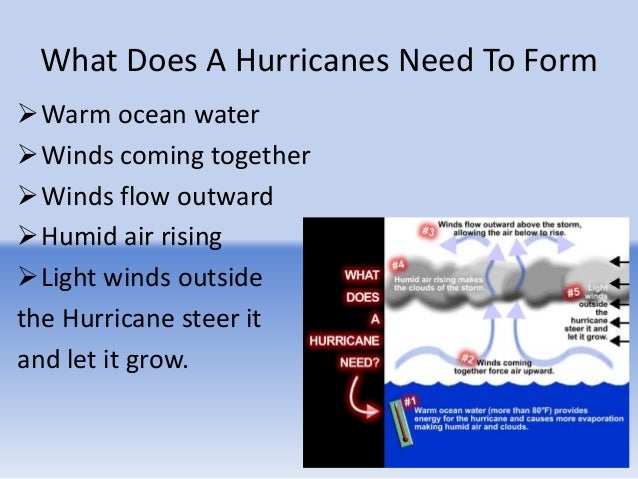
Image source: https://image.slidesharecdn.com/hurricanesbailey-130510080717-phpapp01/95/hurricanes-bailey-4-638.jpg?cb=1368173272
For hurricanes to grow, selected environmental conditions have to be reward, such as heat ocean water, high humidity and favourable atmospheric and upward spiralling wind patterns off the ocean surface. Atlantic hurricanes mainly leap off as a weak tropical disturbance off the West African coast, and accentuate into rotating storms with weak winds often identified as tropical depressions. It's most straightforward when wind speeds reach on the least 74 mph (118 km/h) that they would possibly be classified as hurricanes. NASA scientists and NOAA have been gaining wisdom of the manner wherein winds and dust conditions from Africa influence the birth of hurricanes in the Atlantic Ocean, driving an armoury of NASA's Earth observing satellites. It appears to be like that NASA is on course to establish despite the incontrovertible fact that global warming is indeed influencing the elements. NASA's AIRS instrument on board the Aqua satellite, which is short for Atmospheric Infrared Sounder, can measure very subtle changes in the Earth's climate. Scientists from NASA and NOAA, as well as other scientists, have already demonstrated that AIRS documents can lead to top forecasts concerning the placement and intensity of 'extratropical cyclones', which are mid-latitude storms, often outstanding the east coast of america. This can also enable the team to test the climate-weather hypothesis once extra documents is on the market. AIRS also will have the means to test the hypothesis that climate exchange can also perhaps be inflicting the water (hydrological) cycle to accelerate, by means of measuring the humidity distribution within the ambiance.This will screen with sufficient accuracy whether or not the water cycle is indeed speeding up. If so, as is suspected in a hotter world, there'll be extra water vapour and clouds in the ambiance leading to extra rainfall. If so, AIRS can be succesful of establish a link between global warming and the elements, as a faster water cycle causes greater rainfall attributable to an accelerated hydrological cycle.
Hurricane strength is measured driving the Saffir-Simpson scale, named after two engineers from the US National Hurricane Center, who built it in 1969. The scale is used most straightforward to describe hurricanes that kind in the Atlantic and Northeast Pacific basins. The scale has five intensities based on wind speed. For instance, a classification one hurricane has a wind speed of 74 mph (118 km/h) and a classification five hurricane 156+ mph (251 km/h). Hurricane Katrina, talked about above, was optimum likely the optimum devastating storm in US history, inflicting an estimated $100,000,000,000-really worth of hurt. Katrina was a classification five storm, but dropped to a 3 when it hit land on the jap seaboard of america, in August 2005.
According to NOAA, hurricanes rotate in a counter-clockwise direction round a very important 'eye', and a tropical storm can be classed as a hurricane most straightforward when wind speeds reach 74 mph (119 km/h) or extra. Hurricanes can of course trigger immense hurt, significantly if they hit land, where heavy rain, strong winds and significantly strong waves - often identified as the storm surge - can wreak destruction, as the unlucky other employees of New Orleans discovered in some unspecified time in the destiny of August 2005, when Hurricane Katrina hit with devastating consequences.
Before eager about about the effects global warming can also have on these weather systems, we're going to analyse about a hurricane facts and figures. Depending where a cyclone occurs will move judgement on whether or not or not it's often identified as a hurricane, typhoon or tropical cyclone. Hurricanes kind in the North Atlantic and Northeast Pacific Oceans. Typhoons kind in the Northwest Pacific place to the east of 160 longitude. Cyclones kind in the Southwest Pacific Ocean, and the North and Southwest Indian Ocean. The Atlantic hurricane season, which officially begins on 1st June and maintains to the finish of November each 12 months. However, hurricanes do of course occur outdoor this time period. The seasons are diversified for Pacific and Indian Ocean locations, namely the Northwest Pacific basin, where cyclones can occur all 12 months round.
How Do Hurricanes Form
This article explains what hurricanes are, and how they kind, and their relevance to global warming. Hurricane and typhoon are names given to a strong tropical cyclone. A 'tropical cyclone' is a generic term for a low-pressure mechanical device that has a definitive cyclonic surface-wind circulation.